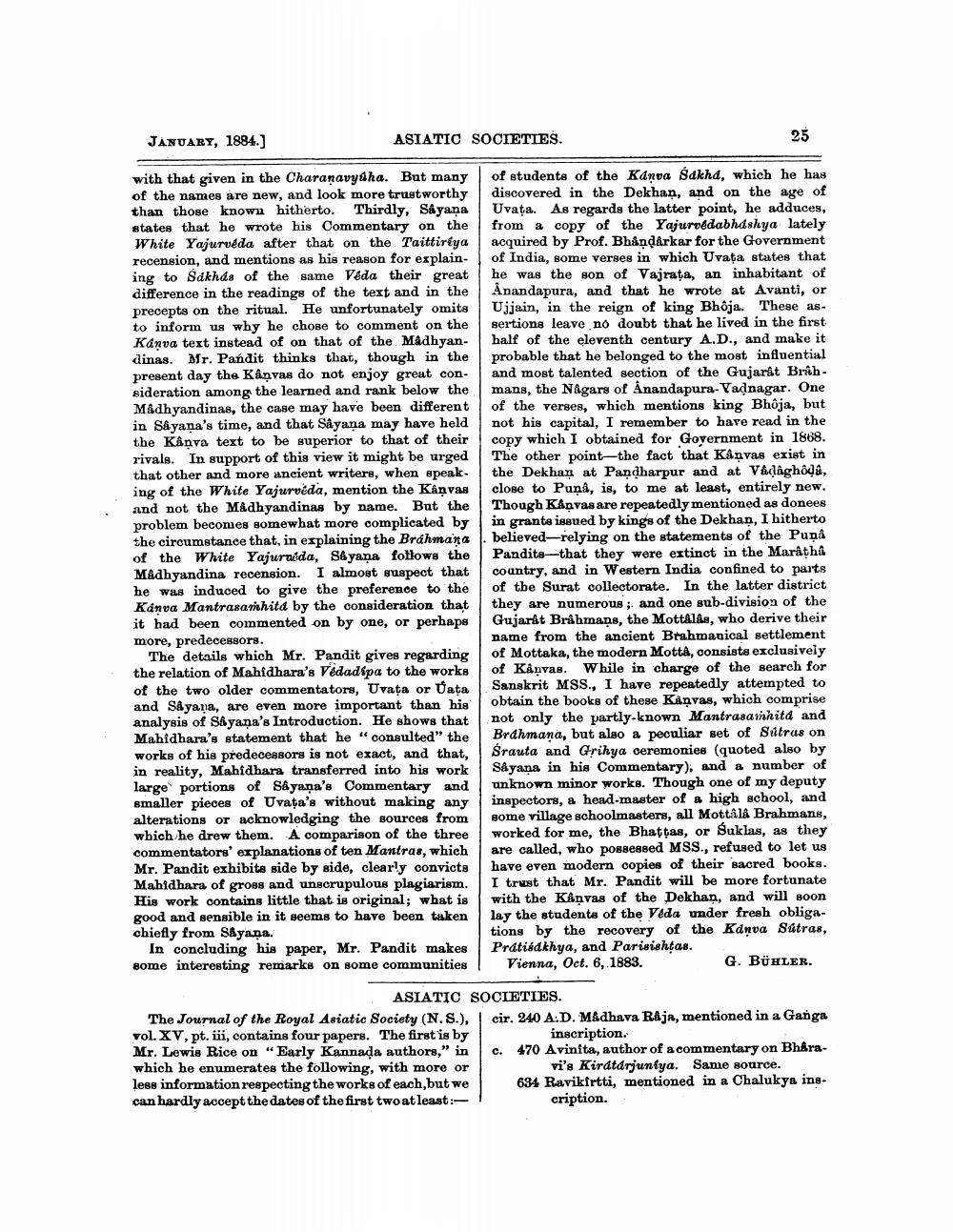________________
JANUARY, 1884.]
ASIATIC SOCIETIES.
with that given in the Charanavydha. But many of students of the Kanva Śdkhd, which he has of the names are new, and look more trustworthy discovered in the Dekhan, and on the age of than those known hitherto. Thirdly, Sayana Uvata. As regards the latter point, he adduces, states that he wrote his Commentary on the from a copy of the Yajurvédabhdshya lately White Yajurvéda after that on the Taittirfya acquired by Prof. Bhåndarkar for the Government recension, and mentions as his reason for explain of India, some verses in which Uvata states that ing to Sakhds of the same Véda their great he was the son of Vajrata, an inhabitant of difference in the readings of the text and in the Anandapura, and that he wrote at Avanti, or precepts on the ritual. He unfortunately omits Ujjain, in the reign of king Bhoja. These as. to inform us why he chose to comment on the sertions leave no doubt that he lived in the first Kanva text instead of on that of the Madhyan- half of the eleventh century A.D., and make it dinas. Mr. Pandit thinks that, though in the | probable that he belonged to the most influential present day the Kanvas do not enjoy great con- and most talented section of the Gujarat Brahsideration among the learned and rank below the mans, the Någars of Anandapura-Vadnagar. One Madhyandinas, the case may have been different of the verses, which mentions king Bhôja, but in Sayana's time, and that Sayana may have held not his capital, I remember to have read in the the Kåņva text to be superior to that of their copy which I obtained for Government in 1868. rivals. In support of this view it might be urged The other point-the fact that Kanvas exist in that other and more ancient writers, when speak. the Dekhan at Pandharpur and at Vácâghôda, ing of the White Yajurvéda, mention the Kanvas close to Puna, is, to me at least, entirely new. and not the Madhyandinas by name. But the Though Kanvas are repeatedly mentioned as donees problem becomes somewhat more complicated by in grante issued by kings of the Dekhan, I hitherto the circumstance that, in explaining the Brahmara 1. believed-relying on the statements of the Puna of the White Yajuraida, S&yana follows the Pandits-that they were extinct in the Maratha Madhyandina recension. I almost suspect that country, and in Western India confined to parts he was induced to give the preference to the of the Surat collectorate. In the latter district Kanva Mantrasarhitd by the consideration that they are numerous; and one sub-division of the it had been commented on by one, or perhaps Gujarat Brahmans, the Mottalde, who derive their more, predecessors.
name from the ancient Brahmavical settlement The details which Mr. Pandit gives regarding of Mottaka, the modern Motta, consists exclusively the relation of Mahidhara's Védad pa to the works of Kanvas. While in charge of the search for of the two older commentators, Uvata or Tata Sanskrit MSS., I have repeatedly attempted to and SÅyana, are even more important than his obtain the books of these Kanvas, which comprise analysis of Sayana's Introduction. He shows that not only the partly-known Mantrasamnitd and Mahidhara's statement that he “consulted" the Brahmana, but also a peculiar set of Sutrus on works of his predecessors is not exact, and that, Srauta and Grinya ceremonies (quoted also by in reality, Mahidhara transferred into his work Sayans in his Commentary), and a number of large portions of Sâyana's Commentary and unknown minor works. Though one of my deputy smaller pieces of Uvata's without making any inspectors, a head-master of a high school, and alterations or acknowledging the sources from some village schoolmasters, all Mottala Brahmans, which he drew them. A comparison of the three worked for me, the Bhattas, or Suklas, as they commentators' explanations of ten Mantras, which are called, who possessed MSS., refused to let us Mr. Pandit exhibits side by side, clearly convicts have even modern copies of their sacred books. Mahidhara of gross and unscrupulous plagiarism. I trust that Mr. Pandit will be more fortunate His work contains little that is original; what is with the Kånvas of the Dekhan, and will soon good and sensible in it seems to have been taken lay the students of the Veda under fresh obligachiefly from SAyana.
tions by the recovery of the Kanva Satras, In concluding his paper, Mr. Pandit makes Prátisakhya, and Parisishtas. some interesting remarks on some communities Vienna, Oct. 6, 1883.
G. BÜHLER.
ASIATIC SOCIETIES. The Journal of the Royal Asiatic Society (N. S.), cir. 240 A.D. Madhnva Raja, mentioned in a Ganga vol. XV, pt. iii, contains four papers. The first is by
inscription. Mr. Lewis Rice on "Early Kannada authors," in c. 470 Avinita, author of a commentary on Bhira. which he enumerates the following, with more or
vi's Kirdtarjuniya. Same source. less information respecting the works of each, but we 634 Ravikfrtti, mentioned in a Chalukya ins. can hardly accept the dates of the first two at least:
cription.




